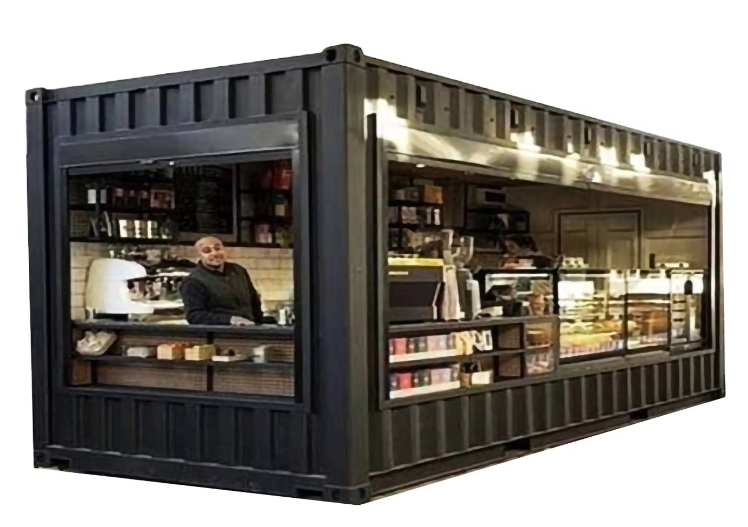In today’s rapidly evolving food and beverage industry, consumers’ demand for experiential dining continues to escal, commercial rents remain high, and traditional restaurant models face dual challenges of cost and innovation. The emergence of container restaurants, however, is breaking the industry’s deadlock with its advantages. These dining spaces, transformed from shipping containers, integrate functionality, sustainability, and design aesthetics, redefining the possibilities of restaurant operations. Whether you are a budget-conscious entrepreneur, a mature brand looking to expand your pop-up stores, or an investor seeking flexible assets, container restaurants can offer solutions that exceed expectations. In the following sections, we delve into this global dining trend to see why it could be your next quality entrepreneurial choice.
I. What exactly is a container restaurant?
Essentially, a container (Restaurant Container) is a fully functional dining space created by transforming standardized shipping containers (mainly 20-foot and 40-foot regular steel containers). is far from a mere “metal box”; instead, it is a specialized and customized dining solution that revolves around the core of catering operations:• Space planning: Based the type of cuisine and business model, it is divided into cooking areas, serving areas, dining areas (some with outdoor seating expansion), storage areas, and even employee rest areas to maximize the use of internal space.
• Functional compatibility
Pre-installed with water and electricity pipelines, ventilation and smoke exhaust systems, slip-resistant floors, and fireresistant ceilings that meet dining standards, and can directly connect with kitchen equipment (such as stoves, refrigerators, and workstations, etc.).• Compliance modification Through structural reinforcement, insulation layer laying, waterproofing treatment, etc., it meets the needs of different climate zones, and at the same time complies with the building and food regulations of the target market.
II. Why have container restaurants become the new darlings of the global food and beverage industry?
Compared with traditional brick-and-ar restaurants, container restaurants offer core advantages in terms of cost, efficiency, and flexibility, perfectly addressing the operational pain points of the current food and beverage industry:
1. Cost, lowering the threshold for entrepreneurship
• Lower construction costs: Relying on standardized container base materials, the renovation cost is only 50%-70% of traditional restaurant decoration cost of the same area, with less material loss and higher budget transparency.
• Less rent pressure: Compact in size and mobile, there is no need to bind high-priced commercial properties in core areas. You can choose to locate in cultural and creative parks, squares, scenic spots, etc., where rent is affordable, significantly reducing initial.
2. Quick implementation, seizing market opportunities
Traditional restaurants often take 3-6 months to renovate and open, while container restaurants adopt a factory pre-rication on-site assembly model: after completing the interior renovation, equipment installation, and soft decoration matching in the factory, it only takes 1-2 weeks to transport the site for commissioning and opening, which is particularly suitable for capturing seasonal customer flow, festival marketing, and other short-term profit windows.
3. Flexible Adation, Unlocking Diverse Scenarios
The “portability” and “modularity” characteristics of container restaurants allow them to adapt to almost all dining scenarios:
Entrepreneurial Trial: Want to open a hamburger shop, coffee bar, or specialty snack shop? Use containers to quickly build a sample store, test market response at low cost and avoid blind investment.
• Brand Pop-up: Mature restaurant brands can use container pop-up stores to enter commercial circles, exhibitions, or music festivals, to precisely young customer groups and strengthen the brand’s trendy attributes.
• Scene Extension: In areas where traditional catering facilities are difficult to cover, such as scenic spots, campsites, coastal walks, container restaurants can quickly fill the gaps and create unique check-in points.
• Space Expansion: Container restaurants can be combined into medium-sized restaurants, bars terraces, and other composite spaces through multiple container splicing, and can be flexibly expanded or relocated according to the growth of customer flow.
4. Outstanding Appearance With Built-in Communication Attributes
The industrial style base of the container is highly designable, whether it is painted with bright colors, matched with green plants and soft decoration, added with elements such as floor-to-ceiling windows and folding bars, it can easily create a popular appearance. This “high-quality appearance” attribute allows consumers to take and share them actively, bringing free social platform communication for the restaurant and reducing marketing costs.
5. Green Sustainability, In Line with Consumer Trends
The use of retired containers for transformation is itself a recycling of steel resources, in line with the “sustainable development” concept advocated globally. For consumers, choosing environmentally friendly restaurants can better meet their values and also make the brand more likable.
III. Customized Solutions for Container Restaurants: Meet Your Unique Needs
As a professional container housing supplier, we can provide a process of customized services according to your catering positioning and target market, and the core customization dimensions include:
|
Custom category |
Core options |
applicable scene |
|
dimensions |
20ft (compact, suitable for snacks/coffee), 40ft (standard, can hold 15-20 people), 40ft high cabinet (expands height, suitable for sophisticated dining bar) | Solo entrepreneurship, small chain, scenario catering |
|
Function configuration |
Basic (only including the operation area + meal outlet), standard (operation area + indoor dining area), upgraded (including independent toilet, refrigeration room, outdoor terrace) | Fast copy mode, dine in mode, high-end experience mode |
|
Equipment integration |
Kitchen equipment (custom stove, fryer, coffee machine), intelligent system (cash register, monitoring, temperature control), environmental protection equipment (oil fume purifier, sewage treatment) | Chinese and Western food, drinks, baking and other different categories |
|
appearance design |
Industrial style (original color + metal frame), ins style (light color + glass elements), theme style (brand IP coating + fixed manufacturing type) |
Internet celebrity stores, brand stores, themed catering projects |
|
Climate adaptation |
Tropical model (enhanced ventilation + sun protection coating), cold model (thick insulation layer + floor heating), rainy model (waterproof membrane + drainage design) |
Southeast Asia, Europe, South America and other different regions |
IV. Choose Our Container Restaurant: Full Process Protection from Design to Delivery
For foreign trade customers, the cross-border procurement of container restaurants to take into account product quality, compliance, and logistics efficiency. Our service advantages can solve your worries:
1. Compliance First: Products comply with the building regulations (such EU CE certification, US ICC certification) and food hygiene standards of the target market, ensuring smooth local approval.
2. Global Logistics Adaptation: Relying on of foreign trade experience, we can coordinate container shipping, customs clearance, and local installation services, providing a “door-to-door” one-stop solution.
3.-sales Service Without Worries: We provide detailed installation instructions and equipment operation guides, and also connect with local cooperative service providers to solve later maintenance, parts replacement, and other issues
Conclusion: With container restaurants, open up your new possibilities in catering
In today’s era when “lightweight entrepreneurship” and “experience-based consumption” have become mainstream, container restaurants are no longer a niche attempt, but an efficient catering model that has been verified by the global market. It reduces the risk of trial and error for restaurateurs its low cost, quick implementation, and high flexibility; and it creates fresh experiences for consumers with its high appearance and strong adaptability.
Post time: Sep-30-2025






